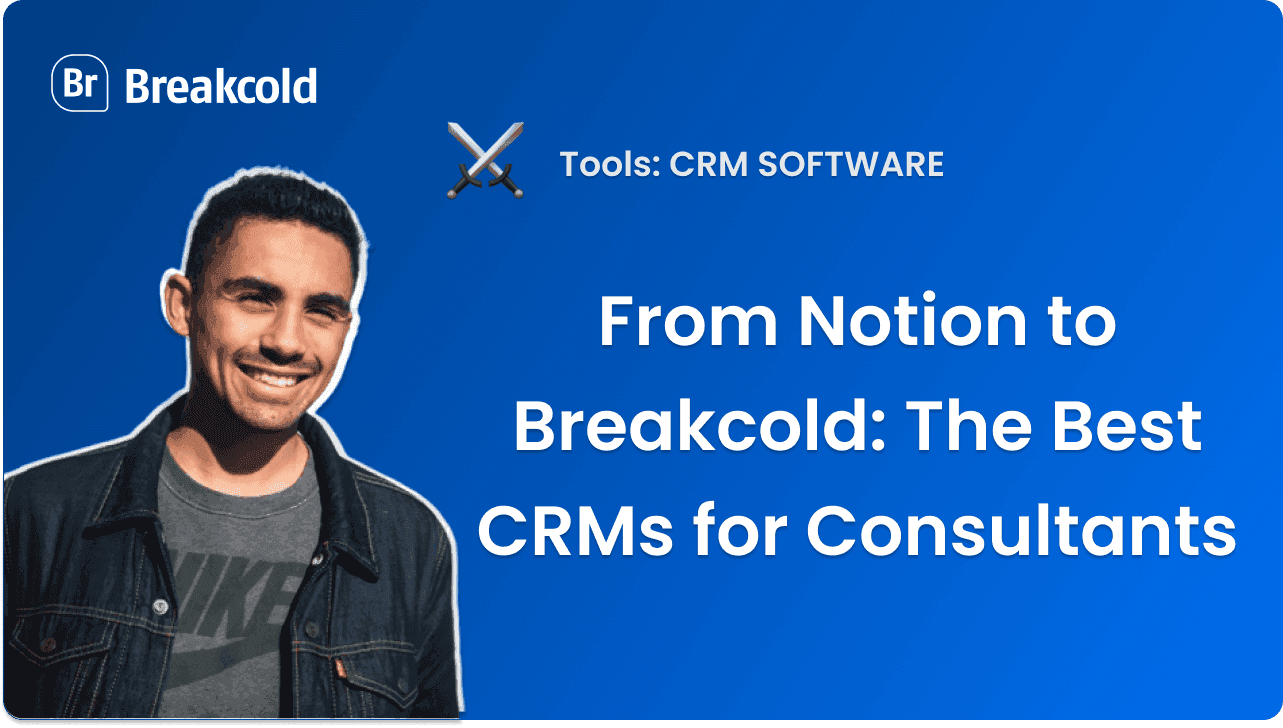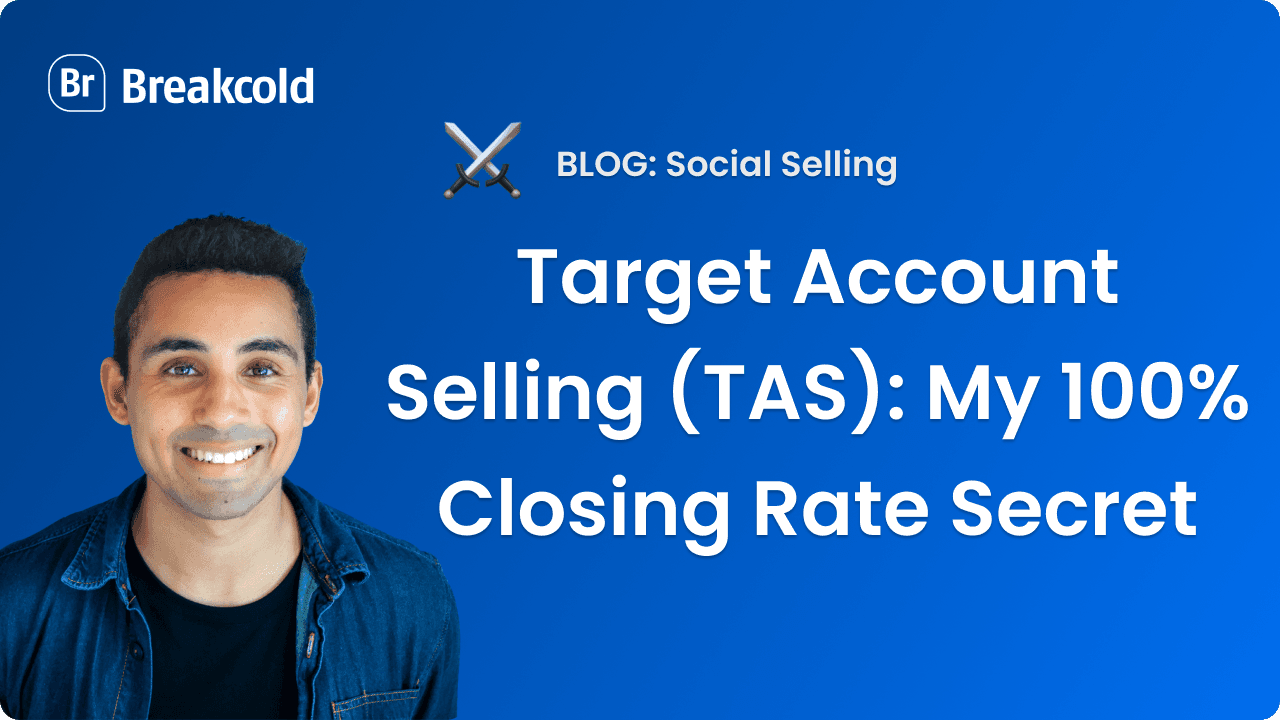
1°) What is Target Account Selling (TAS)?
Target Account Selling (or TAS selling) is a sales prospecting method where you focus just on a limited amount of potential accounts. It’s a technique that is highly used by big enterprise corporations where each SDR, BDR and AE know exactly on who they should focus on.
The advantage of this technique is that you need to focus on just a limited number of people so your goal is to make as many interactions as possible to build strong B2B relationships.
Is TAS selling similar to Account Based Marketing (ABM)?
TAS selling is similar to Account Based Marketing in the sense that it's the same approach on focusing on a small group of buying accounts.
However TAS selling is focused on the sales prospecting part (meaning generating leads and closing deals with cold emailing, cold calling or social selling) while ABM is focused on the ads/marketing side (generating leads with ads and offline/online marketing campaigns).
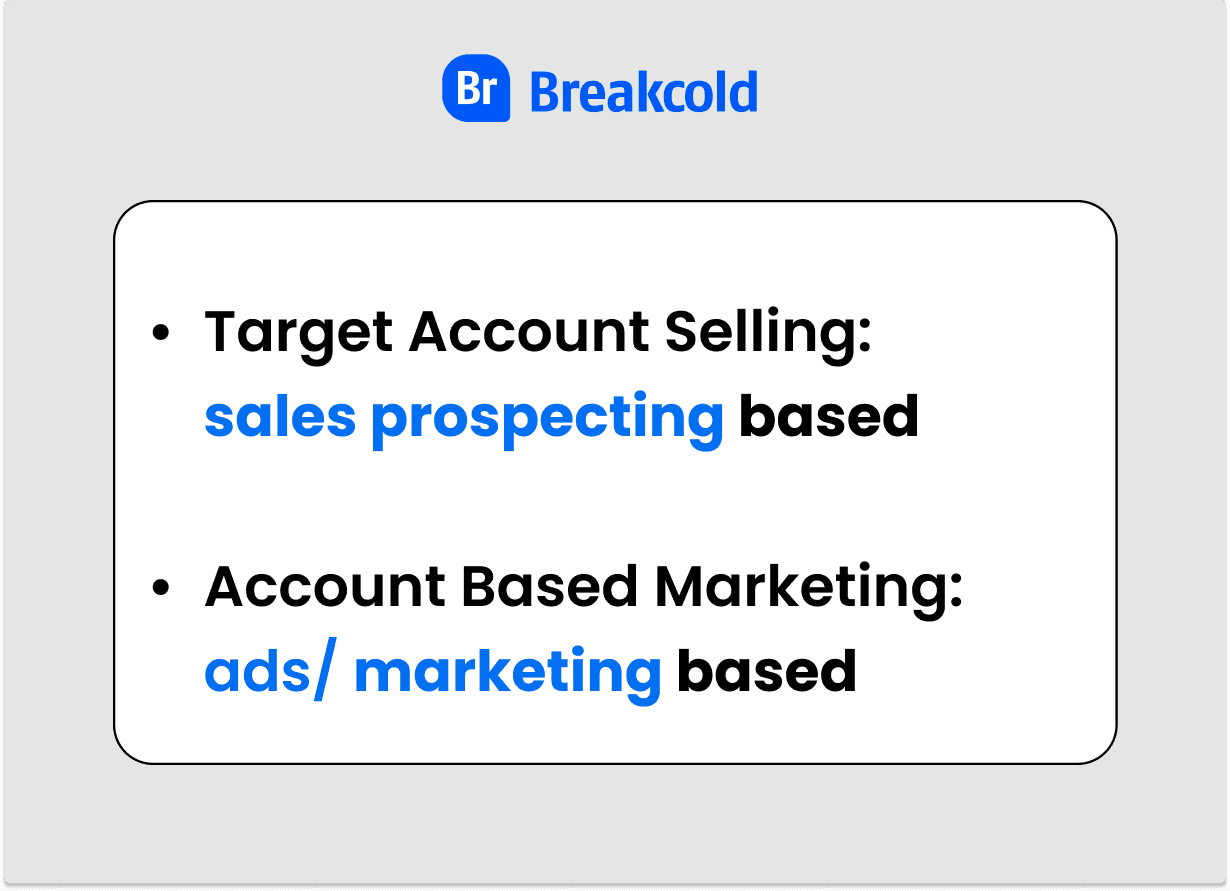
TAS selling vs ABM
2°) Is Target Account Selling suitable for any kind of B2B businesses?
Target Account Selling is technically suitable for any kind of B2B businesses.
If you're a startup, you'll be interested to validate or invalidate your idea by focusing on a small group of individuals.
If you're a digital marketing agency or an enterprise which high-ticket offers, you'll be more interested on focusing on key accounts with personalized outreach techniques rather than burning your whole Total Addressable Market (TAM).
In practice though, Target Account Selling is most suited for business that have a high paying offer (above $2500/month minimum, ideally $20,000+/month). We talked in another article about the cold email personalization ROI, here it's similar, you need to make some calculations to know if it's worth it or not for your sales team to focus on a small set of prospects.
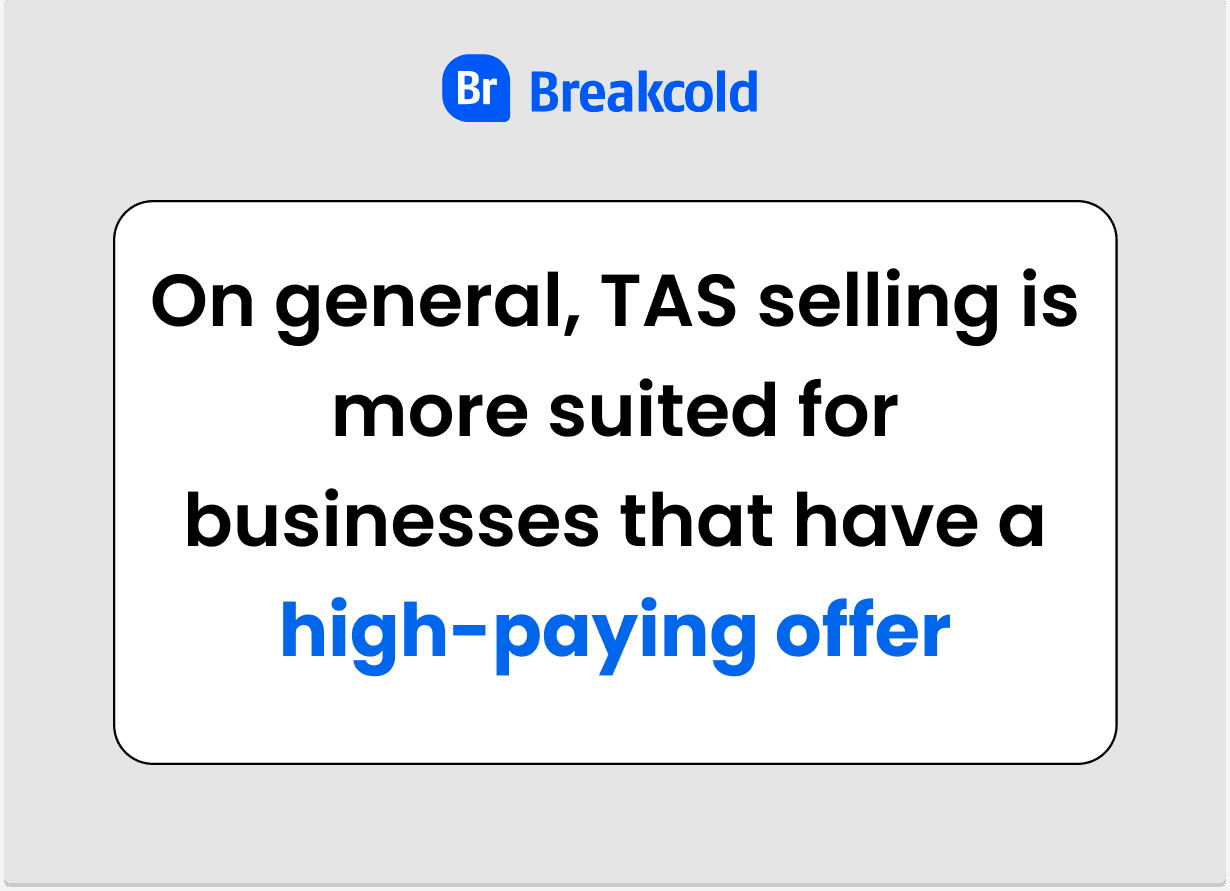
Who is TAS selling for?
To give you an idea, most companies performing TAS selling are usually big tech companies (Enterprise SaaS) with sales reps whose sole job is to focus on specific customers.
But when you think about it, if you're a digital marketing agency for example, it would make sense to focus on your ideal 100 prospects because if you close only a 4 of them, you can end up with +$10,000 in monthly recurring revenue (MRR) depending on your offer. You can then put in place a sales steam to scale the process.
3°) The Target Account selling methodology (the old way vs the new way)
Throughout the years, TAS selling evolved a lot. We went from the aggressive use of mass mailing to the use of traditional sales techniques until the rise of social selling strategies.
1/ The old way of doing TAS selling (traditional sales prospecting techniques)
Before the rise of social selling, people used to do TAS selling only with:
cold calling
door-to-door prospecting
cold emailing
Obviously with the digital era we live in, cold emailing along with warm emailing are the dominant sales acquisition channel here.

TAS selling has matured over the years with the rise of new sales prospecting techniques
The problem when you do TAS selling is that once you've generate warm prospects, you need to keep the B2B relationship going until the sale is closed, so how can you do it?
You basically send follow-up emails then you try to set up another call. These kind of techniques are working but to stay top of mind it's not enough, you'll need to use some ABM strategies as well (ie paying for retargeting ads as well).
This is where Social Selling can help you out.
2/ The next way of doing TAS selling (social selling techniques)
With the rise of social media, notably the B2B ones like LinkedIn you can now interact every day with prospects or get your content visible by them by publishing on LinkedIn.
Social selling is a mix of sales prospecting, B2B relationship building and content marketing using social media. It will help you execute your TAS selling strategy by staying top of mind throughout the whole customer journey of your prospect from the cold to closed sales pipeline stage.

The three pillars of Social Selling
4°) My TAS selling strategies to close deals consistently
The goal: build long lasting B2B relationships
The goal of any TAS selling strategies is to build long lasting B2B relationships because you know that at some point you'll generate warm leads and that they'll become paying customers.
That's exactly what happened with Ana that became a Breakcold customer after a year of interactions on Twitter. All of that thanks to Social Selling with Twitter.
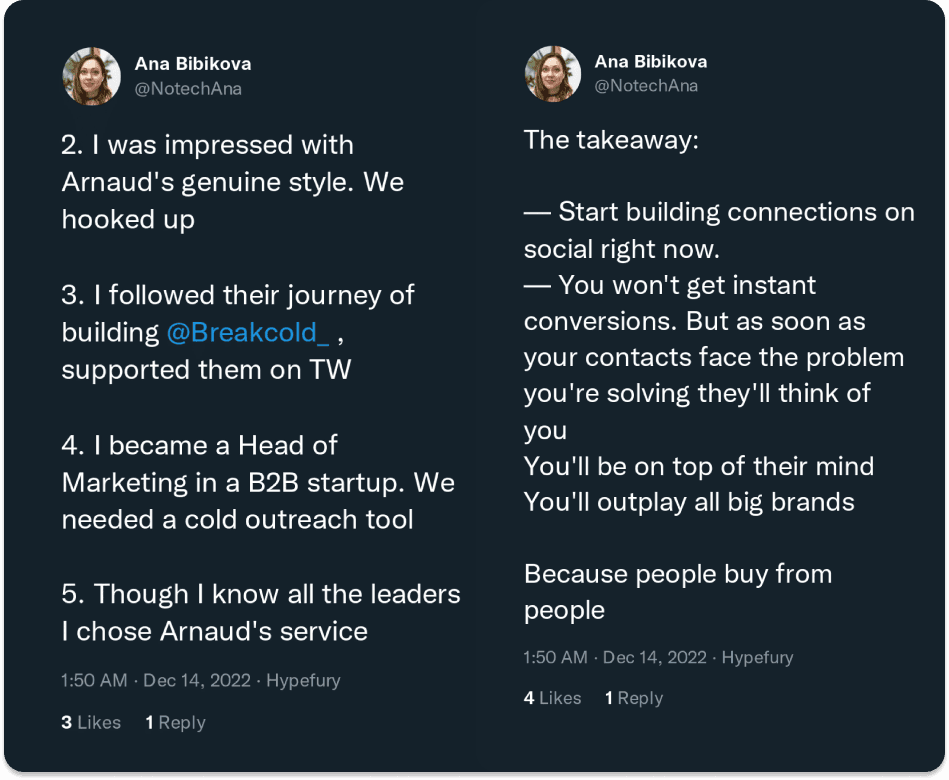
Ana, a Breakcold customer explains the power of building strong B2B relationships
In the following method, I will show you how I generate leads and close deals using social selling. Ready? Let's go!
Step 1: tracking my prospects social media activities
The first step is to find leads and track their activities on social media, especially on LinkedIn and Twitter as this is where B2B leads are the most active generally.
To find B2B leads, I use LinkedIn Sales Navigator and I filter my search to only have the prospects who have been the most active in the last 30 days on LinkedIn. Then I export the data using Findymail.
From there, I import the B2B contacts in my social selling software: Breakcold. Normally I will have the Personal LinkedIn URL of my prospect at the time of the import but I won't have the Personal Twitter URL so I'll find it within minutes for each prospect.
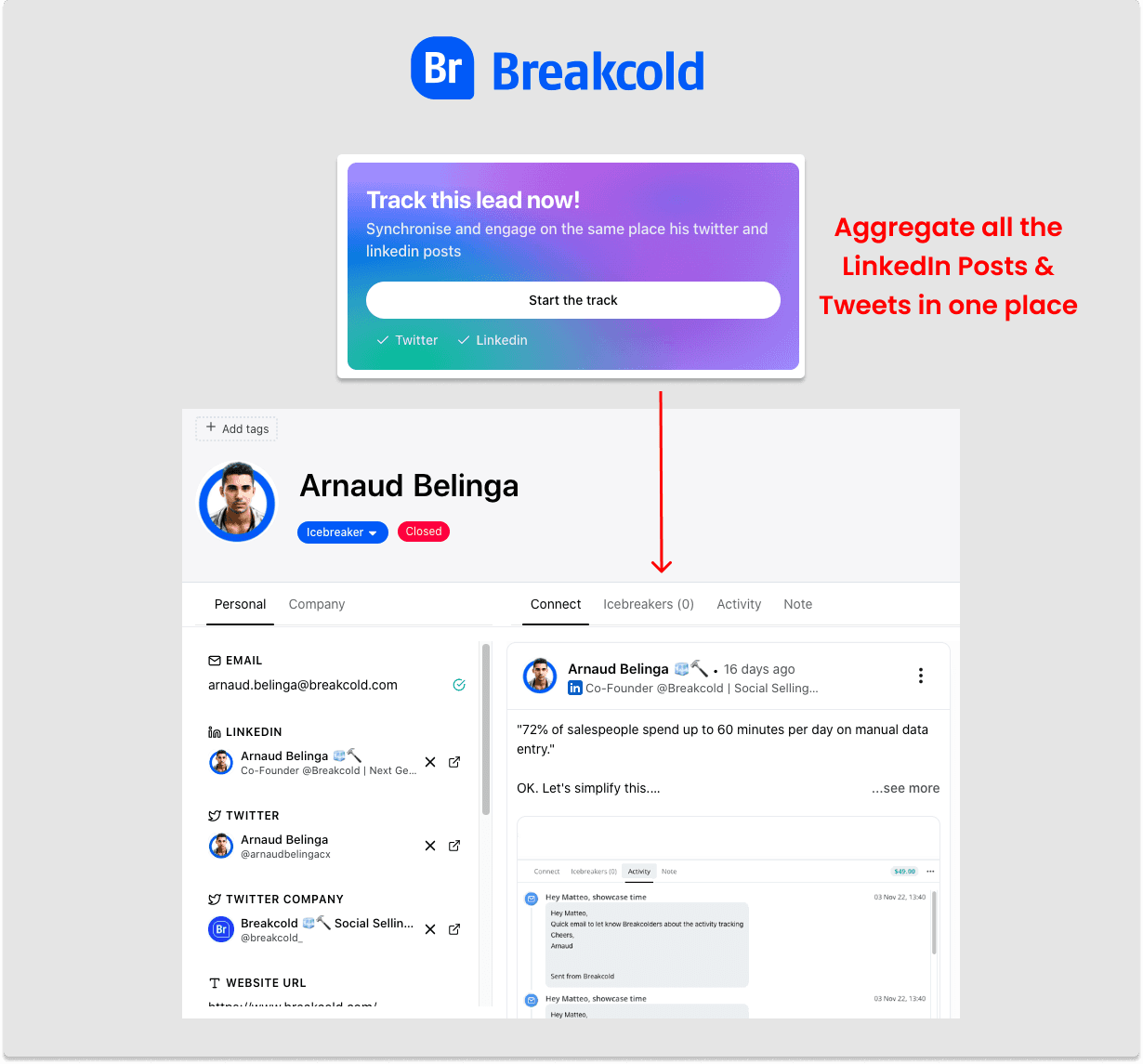
To track leads, you need at least one of their LinkedIn URL or Twitter one
I'll also take the time to find the Twitter company of the prospect because it will be useful in our TAS selling strategy.
Then, I will assign the "Cold Lead" status of to the leads in my social selling pipeline and I'll assign them a contract value so it will motivate me to move them from a sales pipeline stage to another.
Finally, I will start tracking each prospects to aggregate automatically their LinkedIn posts, Tweets along with their company ones so I can save hours on prospect research to personalize faster our cold emails, LinkedIn messages and Twitter messages.
Step 2: taking the right actions at any sales pipeline stages
Ok, we now have everything prepared to execute our TAS selling strategy on steroids.
Stage 1: cold prospects (lead generation phase)
When leads are still cold prospects, we basically need to engage with their social media activity without reaching out to them: that's called Social Warming. It's one of the 6 use cases of a social selling software.

LinkedIn Sales Navigator is a great way to find leads for Target Account Selling
Basically, your first job is to engage prospects on LinkedIn and Twitter.
For that it's pretty simple, scroll your prospecting feed inside Breakcold or look at each lead profile and engage with their most recent posts. Engaging here means leaving a like and a comment under their posts.
If they don't have many posts, go straight to the reach out part of this TAS selling technique.
Stage 2: engaged prospects (lead generation phase)
When leads are still engage prospects, we'll need to perform different actions:
sending them a LinkedIn connection request
keep engaging on LinkedIn or Twitter
publish LinkedIn posts and Tweets
reaching out to them via Twitter, LinkedIn, Email or all three!
1/ Sending them a LinkedIn connection request (optional but key for 4/)
This step is key for the 4th part of our strategy because prospects will see your LinkedIn posts if they follow you LinkedIn because you engage them and they'll probably engage back.
When you send a LinkedIn connection request, don't add an invite message because it's deemed to reduce by 10% your acceptance rate. You don't have to let an invite note if you left likes and comments under prospects posts because they'll remember you.
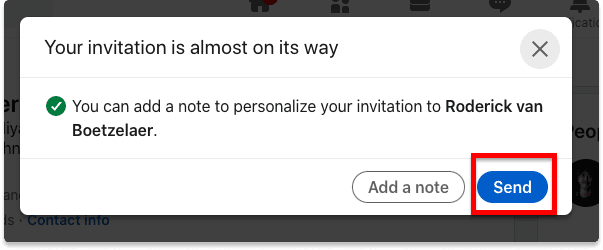
Don't send LinkedIn connection messages
2/ keep engaging on LinkedIn or Twitter but don't reach out immediately
Once prospects replied you back under their comments or that they accepted your connection request on LinkedIn, don't reach out immediately. Instead, keep engaging with them if you want to maximize your chances to get a positive reply.
That way, the first time you'll reach out it won't be a cold message but a semi-cold, semi-warm one. TAS selling is all about building a natural B2B relationship and that's what all the techniques exposed in stage 1 and 2 are.
You don't want to rush the discussion.

Example of a target selling technique using a sales lead tracking software
3/ Publish LinkedIn posts and Tweets
The goal should be to wait between 3 to 7 days after the first interaction you did on the prospect. In the meantime, they might have follow you on Twitter or they will check your account at some point or even accepting your LinkedIn request.
This is where publishing content on both platforms matters for our TAS selling strategy.
The more you'll engage with prospects, the more they'll potentially see your content and it might make them reach out even before you do like it happened to me with Matteo on this picture below.
It's basically what I call a "social selling loop", the more you engage, the more this TAS selling technique works.
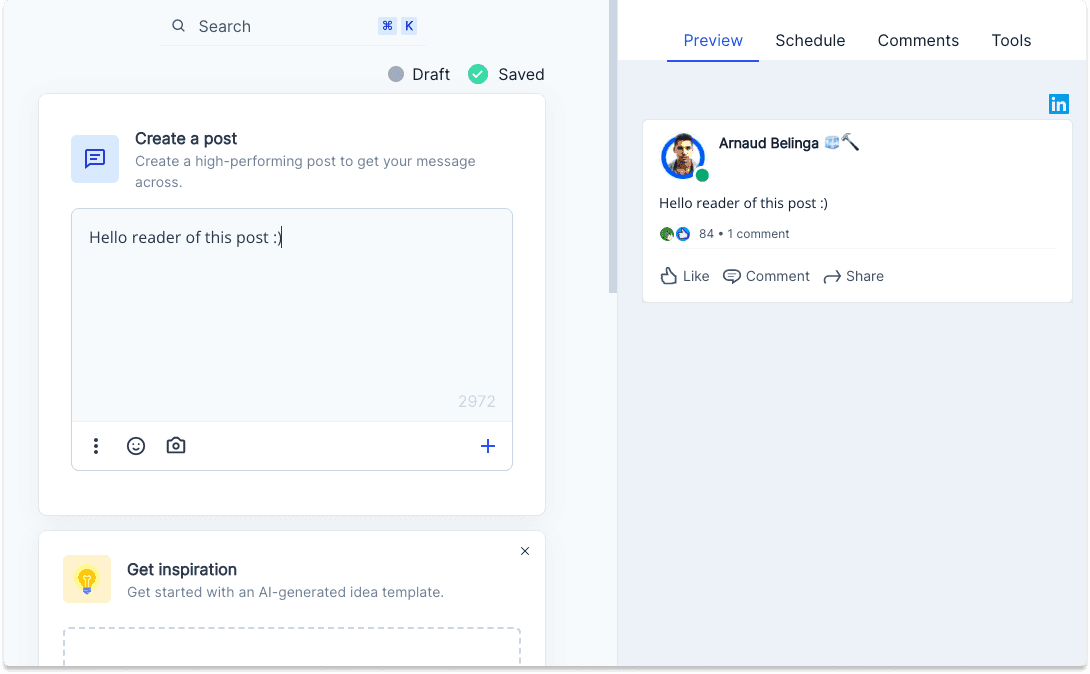
I personally use FeedhHve to publish content on LinkedIn and Twitter as part of my TAS strategy
TAS selling tip: leaving comment under prospect posts who are in your 1st degree connections can boost your LinkedIn engagement to +70%.
4/ Reaching out via Twitter, LinkedIn or Email
Alright, time to reach out prospects!
Reaching out via Twitter
Some prospects are not reachable on Twitter because they didn't open their Twitter DMs.
For the other prospects who open it, you need to know that your Twitter messages will end up in their message requests by default unless they follow you on Twitter. That is by far, the biggest disadvantage of Twitter outreach.
That's why I tend to not send many Twitter DMs to prospects unless they already follow me on Twitter (I have +8,000 followers so it helps!).
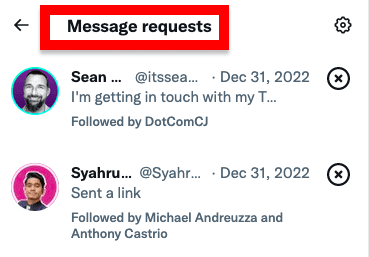
It's not the best way to reach someone by using Twitter
Reaching out via LinkedIn
To reach out someone on LinkedIn, they need to be in your 1st degree connections, this is key for LinkedIn outreach.
To contact a prospect on LinkedIn, I use Breakcold to quickly like and comment a recent post they've made, then I reach out by taking inspirations from what they published in the past. This allows me to come up with something relevant and personalized at the same time.
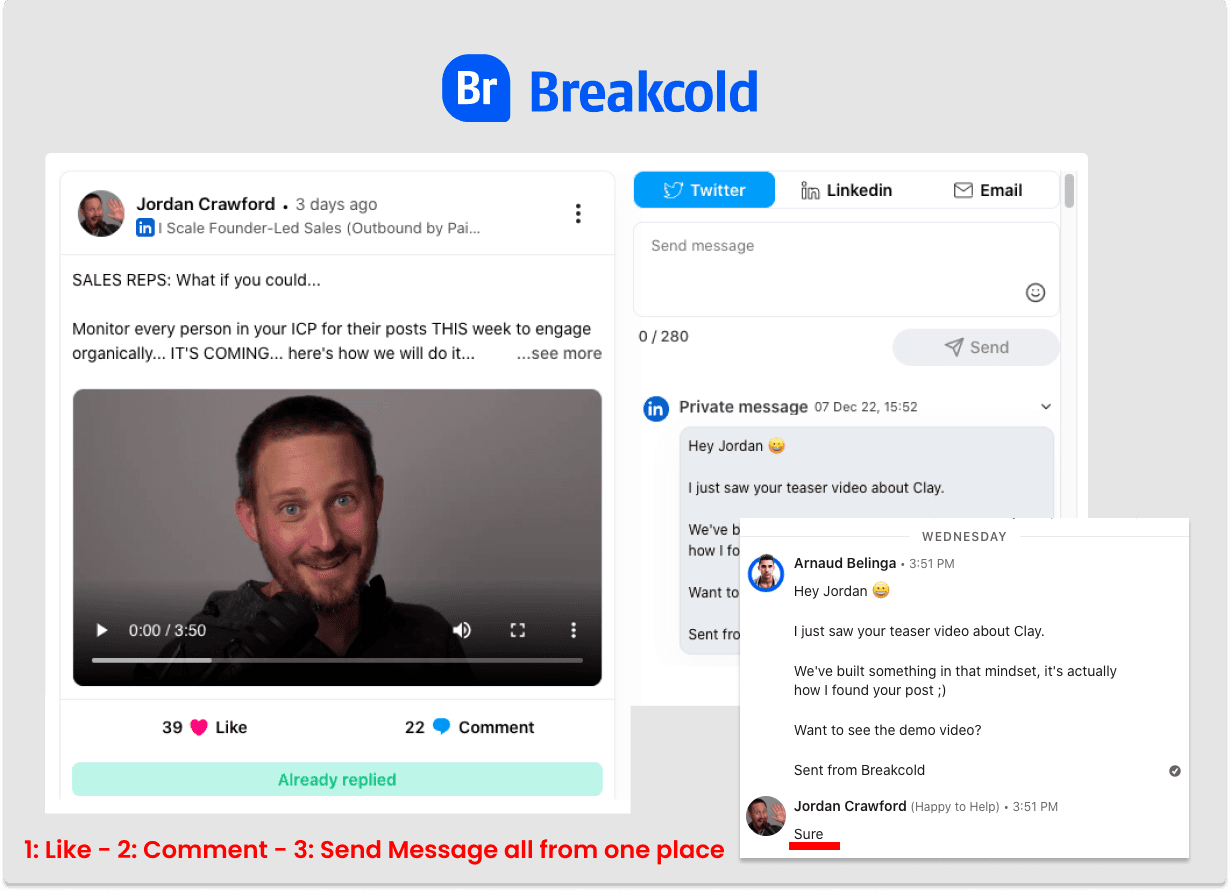
Example of a prospect successfully reach out on LinkedIn
Reaching out via Email
Similar to LinkedIn outreach, I use the news of my prospects on LinkedIn but also the ones from Twitter and his/her company news to come up with a cold email that guarantees me a 100% reply rate (including follow-ups) by using a cold email opening line and a PS line.
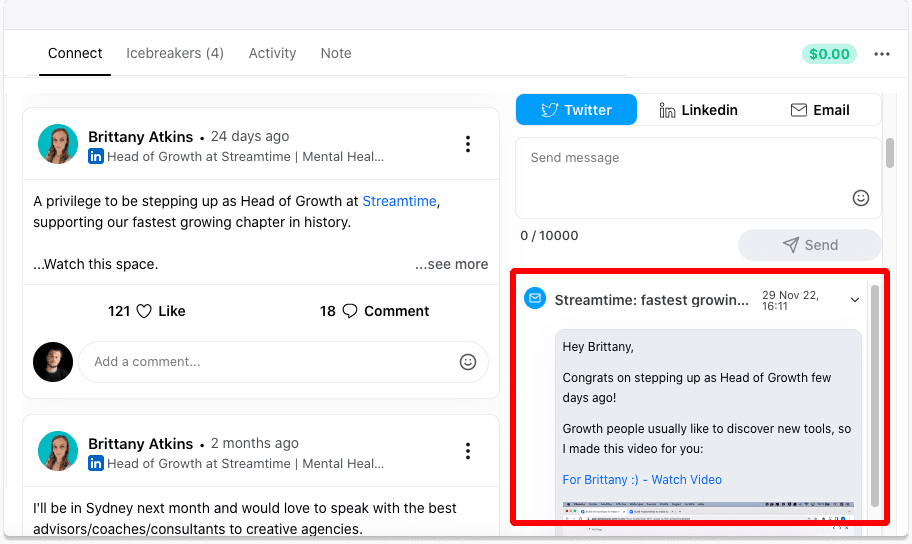
Example of a cold email sent in a TAS selling mindset
Stage 3: warm prospects (closing deal phase)
Note: I explained the action to be taken at stage 1 and stage 2 for you to generate leads with TAS selling but you can start from stage 3 if you get inbound leads from SEO or anything else on your product/service.
When leads are still warm prospects, we'll need to perform different actions:
booking a call with prospects
keep engaging with prospects
sending some follow up emails or messages when it makes sense too
1/ Booking a call with prospects
Once you started your conversations with prospects, try to propose them a call as soon as possible without being pushy, it needs to feel natural. Here's an example on how people have done it on myself in the past once I engaged with them first.
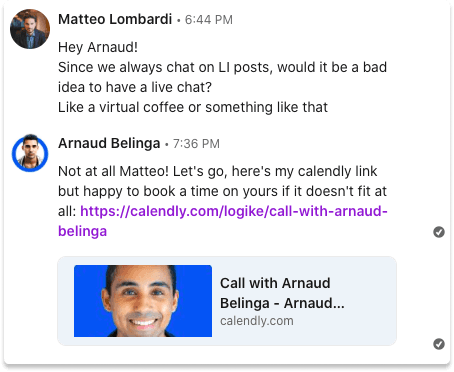
Some prospects will even reach out by themselves
2/ Keep engaging with prospects
Most warm prospects won't become customers straight away, some will hesitate and others will try your product or service and stop half-way through before becoming paying.
You need to stay top of mind and thanks to social selling you can enhance your TAS selling results and accelerate your sales pipeline.
3/ sending follow-up emails or messages when it makes sense to
When you see something relevant in the social media activity of your warm prospects, don't hesitate to contact and nurture them with value content at the same occasion.
Step 3: once the deal is closed, I keep engaging for retention & word of mouth
If you applied correctly all the TAS selling strategies explained with
5°) Network effects about TAS selling
TAS selling by nature, can have wonderful network effects if it's performed in certain manners.
TAS selling on multiple people from the same team
If you focus your TAS selling strategy on multiple people from the same team, you're more likely that they will talk to each other at some point about you and your company.
It's a way to accelerate your sales cycle because not all team members would be emotionally available to dig deeper at your product or service while if you target people in the same team, there will always be one person to look deeper at your solution.

TAS selling network effects
TAS selling on multiple companies for the same network
Imagine you target companies working in the same building or in the same startup network for example, what do you think would happen?
If one of them becomes a paying customer and that they're satisfied they will talk about your product or service to their network but if you already worked on them through TAS selling, you'll close the deal even faster.
6°) Other questions about TAS selling
Is TAS Selling worth executing as a solo business?
Like I mentioned in the introduction, it's worth pursuing TAS selling if you have a high paying offer because this is where you'll get the most ROI of your time. The good thing about TAS selling is that you don't need to exhaust yourself to find new leads all the time, you can focus on what you already have (eg existing warm prospects).
Is Target Account Selling similar to the 100 dream prospects method?
Target Account Selling is similar to the 100 dream prospects method in the sense that in both sales techniques you focus on a small number of prospects.
However you can have different types of prospects in a TAS selling strategy (I mean different ideal customer profiles) while the dream 100 method mentions that you should really aim for your ideal customer no matter how long it would take to close them as customers.




![Why Using A Social Selling CRM? [Versus A Traditional CRM]](https://framerusercontent.com/images/2QaQkaYBYsqJZVbZ4DIcEx01YPY.png)




